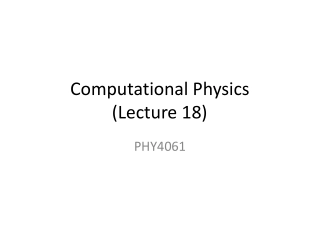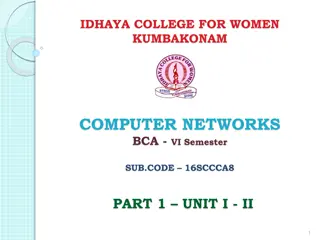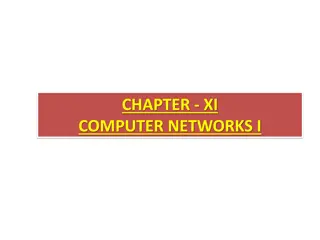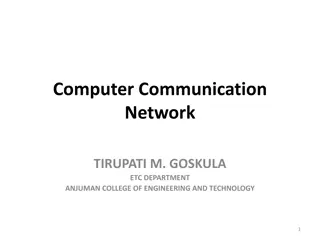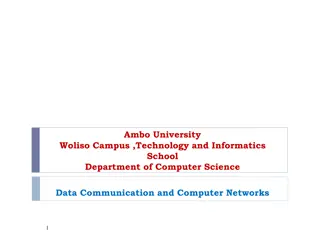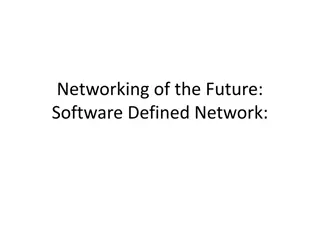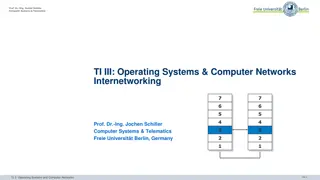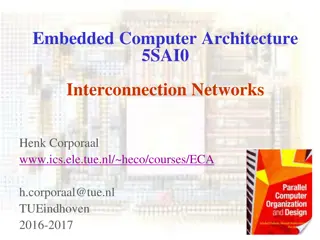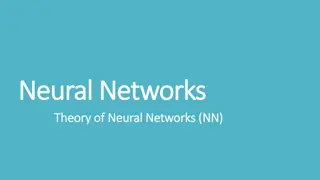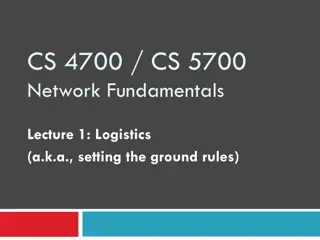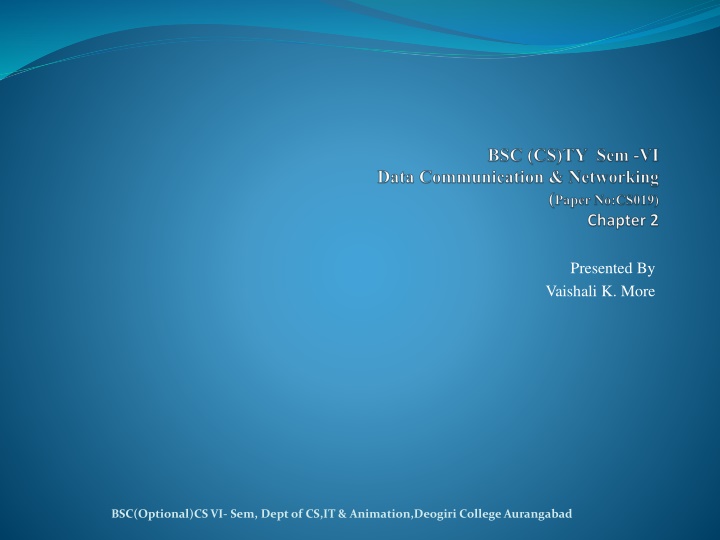
Computer Networks: Advantages, Applications, and Components
"Explore the world of computer networks, from sharing resources to enhancing communication. Learn about the characteristics, components, and applications of computer networks for efficient information sharing and remote access. Discover the diverse benefits of computer networks for businesses and personal use."
Download Presentation

Please find below an Image/Link to download the presentation.
The content on the website is provided AS IS for your information and personal use only. It may not be sold, licensed, or shared on other websites without obtaining consent from the author. If you encounter any issues during the download, it is possible that the publisher has removed the file from their server.
You are allowed to download the files provided on this website for personal or commercial use, subject to the condition that they are used lawfully. All files are the property of their respective owners.
The content on the website is provided AS IS for your information and personal use only. It may not be sold, licensed, or shared on other websites without obtaining consent from the author.
E N D
Presentation Transcript
Presented By Vaishali K. More BSC(Optional)CS VI- Sem, Dept of CS,IT & Animation,Deogiri College Aurangabad
Contents Introduction to Computer Network Advantages & Applications of Computer Network Point to Point Line Configuration Multipoint Line Configuration Types of Network BSC(Optional)CS VI- Sem, Dept of CS,IT & Animation,Deogiri College Aurangabad
Computer Networks Definition: A computer network is a group of computers that use a set of common protocols over digital interconnections for the purpose of sharing resources located on or provided by the network nodes. It is also called as Data Network where you can easily send and receive data to or from a Computing device. These computing device may be PC s, Workstations, Mainframes connected to Printers, modems, CD/DVD ROM and other peripherals for sharing resources over a network communication that are BSC(Optional)CS VI- Sem, Dept of CS,IT & Animation,Deogiri College Aurangabad
Characteristics of Computer Network Sharing Resources from one Computer to another Computer over a network. Performance by measuring the speed of data transmission with number of users, connectivity and the software used. Reliability makes easy to use an alternative source for data communication in case of hardware failure or connectivity issues. Scalability increases the system performance by adding more processors. Security is the main characteristics of Computer network where you can take necessary steps for protecting your data from unauthorized access. BSC(Optional)CS VI- Sem, Dept of CS,IT & Animation,Deogiri College Aurangabad
Components of Computer Network BSC(Optional)CS VI- Sem, Dept of CS,IT & Animation,Deogiri College Aurangabad
Applications of Computer Network Information and Resource Sharing Computer networks allow organizations having units which are placed apart from each other, to share information in a very effective manner. Programs and software in any computer can be accessed by other computers linked to the network. It also allows sharing of hardware equipment, like printers and scanners among varied users. Retrieving Remote Information Through computer networks, users can retrieve remote information on a variety of topics. The information is stored in remote databases to which the user gains access through information systems like the World Wide Web. Speedy Interpersonal Communication Computer networks have increased the speed and volume of communication like never before. Electronic Mail (email) is extensively used for sending texts, documents, images, and videos across the globe. Online communications have increased by manifold times through social networking services. E-Commerce Computer networks have paved way for a variety of business and commercial transactions online, popularly called e-commerce. Users and organizations can pool funds, buy or sell items, pay bills, manage bank accounts, pay taxes, transfer funds and handle investments electronically. BSC(Optional)CS VI- Sem, Dept of CS,IT & Animation,Deogiri College Aurangabad
Applications of Computer Network Continue.. Highly Reliable Systems Computer networks allow systems to be distributed in nature, by the virtue of which data is stored in multiple sources. This makes the system highly reliable. If a failure occurs in one source, then the system will still continue to function and data will still be available from the other sources. Cost Effective Systems Computer networks have reduced the cost of establishment of computer systems in organizations. Previously, it was imperative for organizations to set up expensive mainframes for computation and storage. With the advent of networks, it is sufficient to set up interconnected personal computers (PCs) for the same purpose. VoIP VoIP or Voice over Internet protocol has revolutionized telecommunication systems. Through this, telephone calls are made digitally using Internet Protocols instead of the regular analog phone lines. BSC(Optional)CS VI- Sem, Dept of CS,IT & Animation,Deogiri College Aurangabad
Configuration of Network Point to Point Configuration Multipoint Configuration Multipoint Communication means the channel is shared among multiple devices or nodes. In this communication, link is provided all times for share the connection among nodes. In this communication, the entire capacity is depend on the quick sharing. In Multi-point connections, the smallest distance is not important to reach the receiver. Multi-point communication does not provides security and privacy because communication channel is shared. Point to point communication means the channel is shared between two devices. In this communication, There dedicated link between two nodes. In this communication, the entire capacity is reserved between these connected two devices. In this communication, there is one transmitter and one receiver. In point-to-point connections, the smallest distance is most important to reach the receiver. is BSC(Optional)CS VI- Sem, Dept of CS,IT & Animation,Deogiri College Aurangabad
Configuration of Network Point to Point Configuration Multipoint Configuration Point-to-point communication provides security and privacy because communication channel is not shared. In this communication, there is one transmitter and many receivers. BSC(Optional)CS VI- Sem, Dept of CS,IT & Animation,Deogiri College Aurangabad
BSC(Optional)CS VI- Sem, Dept of CS,IT & Animation,Deogiri College Aurangabad
LAN : Local Area Network BSC(Optional)CS VI- Sem, Dept of CS,IT & Animation,Deogiri College Aurangabad
LAN : Local Area Network Acomputer network spanned inside a building and operated under single administrative system is generally termed as Local Area Network (LAN). Usually, LAN covers an organization offices, schools, colleges or universities. Number of systems connected in LAN may vary from as least as two to as much as 16 million. LAN provides a useful way of sharing the resources between end users. The resources such as printers, file servers, scanners, and internet are easily sharable among computers. LANs are composed of inexpensive networking and routing equipment. It may contains local servers serving file storage and other locally shared applications. It mostly operates on private IP addresses and does not involve heavy routing. LAN works under its own local domain and controlled centrally. LAN uses either Ethernet or Token-ring technology. Ethernet is most widely employed LAN technology and uses Star topology, while Token-ring is rarely seen. LAN can be wired, wireless, or in both forms at once. BSC(Optional)CS VI- Sem, Dept of CS,IT & Animation,Deogiri College Aurangabad
MAN : Meteropolitian Area Network BSC(Optional)CS VI- Sem, Dept of CS,IT & Animation,Deogiri College Aurangabad
MAN : Metropolitan Area Network The Metropolitan Area Network (MAN) generally expands throughout a city such as cable TV network. It can be in the form of Ethernet,Token-ring, ATM, or Fiber Distributed Data Interface (FDDI). Metro Ethernet is a service which is provided by ISPs. This service enables its users to expand their Local Area Networks. For example, MAN can help an organization to connect all of its offices in a city. Backbone of MAN is high-capacity and high-speed fiber optics. MAN works in between Local Area Network and Wide Area Network. MAN provides uplink for LANs to WANs or internet. BSC(Optional)CS VI- Sem, Dept of CS,IT & Animation,Deogiri College Aurangabad
WAN : Wide Area Network BSC(Optional)CS VI- Sem, Dept of CS,IT & Animation,Deogiri College Aurangabad
WAN : Wide Area Network As the name suggests,the Wide Area Network (WAN) covers a wide area which may span across provinces and even a whole country. Generally, telecommunication networks are Wide Area Network. These networks provide connectivity to MANs and LANs. Since they are equipped with very high speed backbone, WANs use very expensive network equipment. WAN may use advanced technologies such as Asynchronous Transfer Mode (ATM), Frame Relay, and Synchronous Optical Network (SONET). WAN may be managed by multiple administration. BSC(Optional)CS VI- Sem, Dept of CS,IT & Animation,Deogiri College Aurangabad
PAN : Personal Area Network BSC(Optional)CS VI- Sem, Dept of CS,IT & Animation,Deogiri College Aurangabad
PAN : Personal Area Network A Personal Area Network (PAN) is smallest network which is very personal to a user. This may include Bluetooth enabled devices or infra-red enabled devices. PAN has connectivity range up to 10 meters. PAN may include wireless computer keyboard and mouse, Bluetooth enabled headphones, wireless printers and TV remotes. For example, Piconet is Bluetooth-enabled Personal Area Network which may contain up to 8 devices connected together in a master-slave fashion. BSC(Optional)CS VI- Sem, Dept of CS,IT & Animation,Deogiri College Aurangabad

